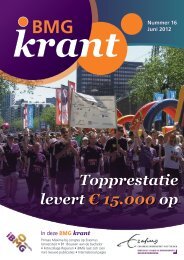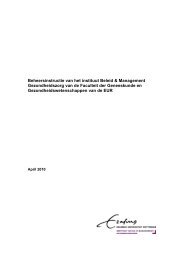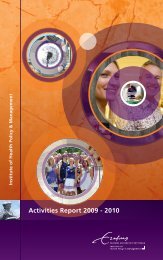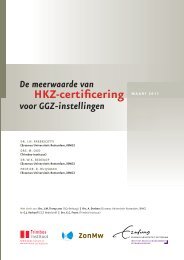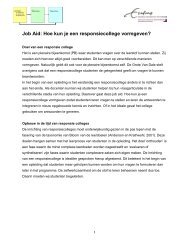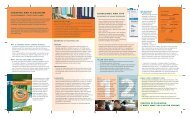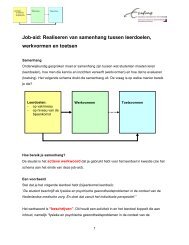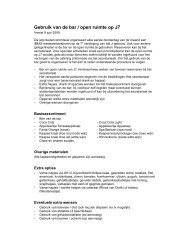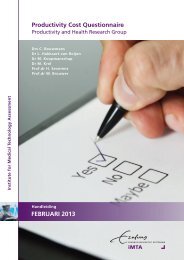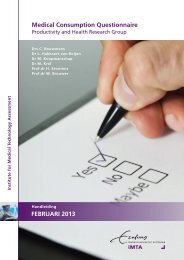28Chapter 2occur in ARM patients. Taking medical consumption as an indication of quality oflife, the quality of life of ARM patients is lower than that of the generalpopulation. Nevertheless, the EQ-5D results show that the impact of stooldifficulties on the overall quality of life is limited. Given the concerns about thequality of life of ARM patients mentioned above, this finding is encouraging. Costeffectiveness(cost per QALY of € 2,482) is good.We were interested to know whether the type of malformation (high or low) andthe mode of treatment affect the long-term consequences of ARM. However, itwas only possible to elicit this information for patients born between 1993 and1996 (who constitute less than one seventh of all responders). To retrieve thisinformation for older patients would require in-depth, time-consuming research,given the long time interval and the lack of computerized data. With theexception of the direct medical costs (Table 2.2), we were, therefore, unable tomake this distinction for all costs and effects. Our knowledge of the impact of thetype of malformation and the mode of treatment is, therefore, restricted to thefirst few years after birth. No conclusions can be made currently on the effect onlong-term costs and effects and on cost-effectiveness.To determine direct medical costs, we adopted a combination of top down andbottom up calculations. It can be disputed whether the efforts required to applytime-consuming bottom up methods for all cost items are in proportion to theinfluence on the comparison between treatment and no treatment. We verified inadvance whether abandoning precise bottom up methods would crucially affectthe outcomes, and, when in doubt, we selected the bottom up technique. We,therefore, expect that the outcomes will not change substantially when all costsare calculated using precise bottom up methods.Economic analyses always are partly based on assumptions. As far as possible wechose solutions that were more likely to overestimate the costs of treatment, sowe consider it to be unlikely that we have presented a too favorable picture ofcost-effectiveness. This applies to all 4 cost categories.The skew of the distribution of the direct medical costs is striking (Table 2.2).This can be explained partly by 3 'outliers' who spent respectively 128, 46, and30 days in the intensive care department. Obviously, a certain spread in the costsis foreseeable because of 'regular' complications. However, when taking this intoaccount, part of this spread could probably be attributed to comorbidity.Therefore, the costs that can be attributed to the treatment of ARM are likely tobe overestimated. This observation is not only valid in these 3 apparent 'outliers'but also in other patients. These questions also apply to the indirect medicalcosts. As mentioned previously, it was our intention to exclude future healthcarecosts of unrelated diseases, but costs of comorbidity inevitably enter into thecalculations. It is particularly difficult to understand the higher number of nightsspent in hospital by patients aged 20 years and older as a consequence of ARM.
Cost-Effectiveness of Treatment for Congenital Anorectal Malformations 29This again implies that the cost-effectiveness ratio is likely to be a conservativeestimate that possibly underestimates the cost-effectiveness of treatment forARM.The study had an adequate response rate (69%), considering the long periodbetween the treatment and the date of the investigation. It is unlikely that thenonresponse influenced the calculated treatment costs because, from a medicalpoint of view, the severity of the malformation does not noticeably differ betweennonresponders and responders. However, we cannot be certain that the quality oflife of the nonresponders does not differ from the responders. Because wefollowed our initial contact with a telephone reminder, we had some opportunityto investigate the reasons for nonresponse, but the results were ambiguous.Some nonresponders seemed to indicate that they had a lower quality of life,citing reasons for nonresponse as 'various health problems', 'nonacceptance','avoidance', and 'behavioral and family problems'. Other nonresponders,however, suggested that quality of life was underestimated. Some stated thatthey were not participating in the investigation because they had no healthproblems. Although no firm conclusions can be drawn, it seems likely that thequality of life of the nonresponders did not differ considerably from theresponders.Remarkably, the results suggest that quality of life of ARM patients does not differgreatly from the general population. The mean EQ-5D index score for their healthstate is 0.88 compared with 0.93 in the general population. On the basis of theliterature, we expected a more severe impairment of quality of life. 4-8 It could ofcourse be argued that the EQ-5D is not sufficiently sensitive to detect stooldifficulties. However, former research in this patient group confirmed thesensitivity of the EQ-5D to clinical differences in all age groups where it wasadministered (i.e., from 5 years on). 23Because of difficulties that small children have with notions of abstract conceptsand language, we used the parents as proxies to answer the disease-specificquestionnaire and the EQ-5D. We are conscious of the variety of factors that caninfluence a parent's rating of his or her child's quality of life and the equivocalfindings reported in the literature. 24-29 Nevertheless, recent research findings inchildren 30-36 seem to suggest that a parent is able to report appropriateinformation regarding his or her child's quality of life, especially when observable,concrete questions are asked (e.g., about mobility, usual activities). Furthermore,when the parent and the child disagree about the child's quality of life, the parenttends to rate the child as having a poorer quality of life than the child does him orherself. In this investigation, such a tendency would result in a more conservativeestimate of cost-effectiveness. Moreover, we also compared the proxy version ofthe EQ-5D in these patients with another proxy questionnaire, the TACQOL,whose validity in children has been confirmed previously. 37 The EQ-5D showedgood validity from 5 years and over. 23 We consider, therefore, that the favorable
- Page 3: COST-EFFECTIVENESS OF NEONATAL SURG
- Page 6 and 7: DOCTORAL COMMITTEEPromotors:Prof.dr
- Page 9 and 10: PUBLICATIONSChapters 2 to 7 are bas
- Page 11: 6ChapterINFORMAL CARE FOR CHILDREN
- Page 14 and 15: 2Chapter 11.1 BACKGROUND AND MOTIVA
- Page 16 and 17: 4Chapter 1provides a good overview
- Page 18 and 19: 6Chapter 1disability, and death of
- Page 21: Introduction 9particular equity pri
- Page 25 and 26: Introduction 1320. Oostenbrink JB,
- Page 27 and 28: Introduction 1554. Heyman MB, Harma
- Page 29 and 30: THE COST-EFFECTIVENESS OFTREATMENT
- Page 31: Cost-Effectiveness of Treatment for
- Page 35 and 36: Cost-Effectiveness of Treatment for
- Page 37 and 38: Cost-Effectiveness of Treatment for
- Page 39: Cost-Effectiveness of Treatment for
- Page 43 and 44: Cost-Effectiveness of Treatment for
- Page 45: Cost-Effectiveness of Treatment for
- Page 48 and 49: 36Chapter 3ABSTRACTBackground/Purpo
- Page 50 and 51: 38Chapter 33.2 MATERIALS AND METHOD
- Page 52 and 53: 40Chapter 3child's date of birth) a
- Page 54 and 55: 42Chapter 3diaphragm was closed (Ta
- Page 56 and 57: 44Chapter 3Total costs of treatment
- Page 58 and 59: 46Chapter 3Regarding the treatment
- Page 60 and 61: 48Chapter 3REFERENCES1. Stolk EA, P
- Page 62 and 63: 50Chapter 332. Jaillard S, Pierrat
- Page 64 and 65: 52Chapter 4ABSTRACTAims:To examine
- Page 66 and 67: 54Chapter 4Outcome measuresThe pati
- Page 68 and 69: 56Chapter 4Clearly, the symptoms st
- Page 70 and 71: 58Chapter 4The respondents did not
- Page 72 and 73: 60Chapter 4Table 4.4TAIQOL Scores o
- Page 74 and 75: 62Chapter 44.4 DISCUSSIONIn this pa
- Page 76 and 77: 64Chapter 4ACKNOWLEDGMENTSWe are in
- Page 78 and 79: 66Chapter 418. Coons SJ, Rao S, Kei
- Page 80 and 81: 68Chapter 5ABSTRACTObjective:Extrac
- Page 82 and 83: 70Chapter 5treatment. 26,27 Finally
- Page 84 and 85: 72Chapter 5CostsOnly direct costs w
- Page 86 and 87: 74Chapter 5summarized in Table 5.2.
- Page 88 and 89: 76Chapter 5Table 5.3 Direct Medical
- Page 90 and 91:
78Chapter 5Figure 5.3 illustrates o
- Page 92 and 93:
80Chapter 5severely ill newborns—
- Page 94 and 95:
82Chapter 5REFERENCES1. Bartlett RH
- Page 96 and 97:
84Chapter 533. Meinert CL: Extracor
- Page 98 and 99:
86Chapter 568. Hui TT, Danielson PD
- Page 100 and 101:
88Chapter 6ABSTRACTObjective:To inv
- Page 102 and 103:
90Chapter 6a rule. The health-relat
- Page 104 and 105:
92Chapter 6Regression analysis of h
- Page 106 and 107:
94Chapter 6that caregiving for thei
- Page 108 and 109:
96Chapter 6Table 6.5 CareQol Compar
- Page 110 and 111:
98Chapter 6children with a disabili
- Page 112 and 113:
100Chapter 6This study was of impor
- Page 114 and 115:
102Chapter 618. Poley MJ, Stolk EA,
- Page 116 and 117:
104Chapter 654. Boman KK, Viksten J
- Page 118 and 119:
106Chapter 7ABSTRACTMortality rates
- Page 120 and 121:
108Chapter 77.2 THE RELEVANCE OF CO
- Page 122 and 123:
110Chapter 7In the early 2000s, our
- Page 124 and 125:
112Chapter 7Table 7.1 Economic Eval
- Page 126 and 127:
114Chapter 7More from a policy pers
- Page 128 and 129:
116Chapter 7also expect that life-s
- Page 130 and 131:
118Chapter 7entirely justified, for
- Page 132 and 133:
120Chapter 723. Sydorak RM, Nijagal
- Page 134 and 135:
122Chapter 765. Glaser AW, Davies K
- Page 137 and 138:
GENERAL DISCUSSION:A GUIDED TOURPRO
- Page 139 and 140:
General Discussion: A Guided Tour P
- Page 141 and 142:
General Discussion: A Guided Tour P
- Page 143 and 144:
General Discussion: A Guided Tour P
- Page 145 and 146:
General Discussion: A Guided Tour P
- Page 147 and 148:
General Discussion: A Guided Tour P
- Page 149 and 150:
General Discussion: A Guided Tour P
- Page 151:
General Discussion: A Guided Tour P
- Page 154 and 155:
142GlossaryCharge (or: tariff)A pri
- Page 156 and 157:
144Glossaryefficient one. We are th
- Page 159 and 160:
SUMMARY
- Page 161 and 162:
Summary 149mortality. Finally, it i
- Page 163 and 164:
Summary 151neonatal surgery. It is
- Page 165 and 166:
SAMENVATTING
- Page 167 and 168:
Samenvatting 155zoals directe niet-
- Page 169 and 170:
Samenvatting 157Hoofdstuk 6 gaat ve
- Page 171:
Samenvatting 159vereisen, waarvoor
- Page 174 and 175:
162AcknowledgmentsAlthough I am ind
- Page 176:
About the AuthorBorn in De Meern (N





